[ad_1]
Colum’s daring to hope again, Gavin’s nervous, Michelle’s wondering why, and Doug, Jim and Naomi all wear broad smiles, at least for the time it takes them to read the BT’s latest Lucid Talk poll.
DUP: This is the first poll since the dramatic fall of Jeffrey Donaldson and all eyes will have turned first to the DUP figure. And it’s not good.
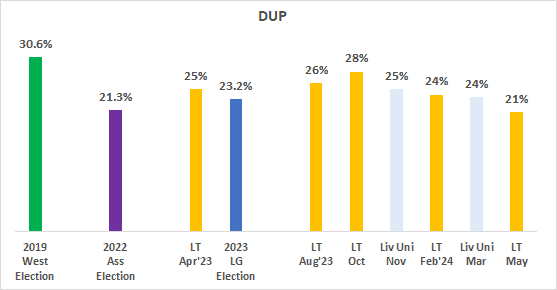

The party has lost all the gains it had made since it fell into second place at the last Assembly elections. This is most definitely not where the party needs to be six months out from the likely date of a Westminster election and would put up to half of the eight seats it won in 2019 in danger.
It would be easy to conclude the party’s problems are simply the result of the charges against their former leader. But I am not totally convinced. The party reached its highest post-election poll rating in October last year when it was still shoulder-to-shoulder with the TUV, boycotting Stormont in protest at the Windsor Framework/Protocol. It took a hit, slipping four points, when it adopted the Donaldson deal to return to the Executive.
But this further 3 point slip comes in the same poll which shows the approval ratings of the party’s Stormont leader, Emma Little-Pengelly, jump a whopping 21 points from 31% to 52%, and the party’s new leader, Gavin Robinson, clock in at 46%, a full 10 points higher than Donaldson scored three months ago.
If the party is suffering from its association with Donaldson, why would its two leading figures not share in the damage?
If the problem is that the Donaldson deal itself is losing support, why would the two DUP politicians most associated with the Donaldson deal after Donaldson himself prosper?
If the drop is simply a deviation on the outer fringes of the margin of error (2.3%) that would be inconsistent with their leaders’ rising approval ratings.
It could be that the DUP’s return to the Executive is proving generally popular outside party-political unionism as well as within a large section of unionist voters. They like what they see (or at least prefer it to what went before) and their view of DUP politicians associated with it grows a little warmer, but not enough to reward them with a vote. Meanwhile some of those DUP voters who gave the party the benefit of the doubt on the Donaldson deal may be having second thoughts.
TUV: The beneficiary of the DUP’s woes is also back to their Assembly election support level.
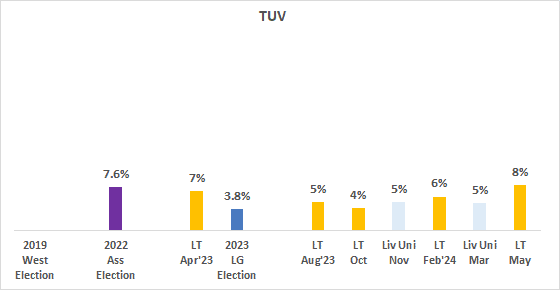

While this would probably not give them a second seat in another Assembly election it would place them on the tipping point where only slightly higher levels of support would start to bring in seats. Of more immediate importance, this level of vote in a Westminster election would give them a good chance of winning North Antrim from the DUP. It could also serve their aim, with their partners in Reform UK, of damaging the DUP sufficiently to lose seats to other parties.
The following chart shows who would have won each constituency in 2019 at different levels of TUV/Reform total NI vote share. The TUV/Reform votes are distributed to each constituency in the same proportions as the TUV won in the 2022 Assembly election. The TUV/Reform votes have been subtracted from the DUP.
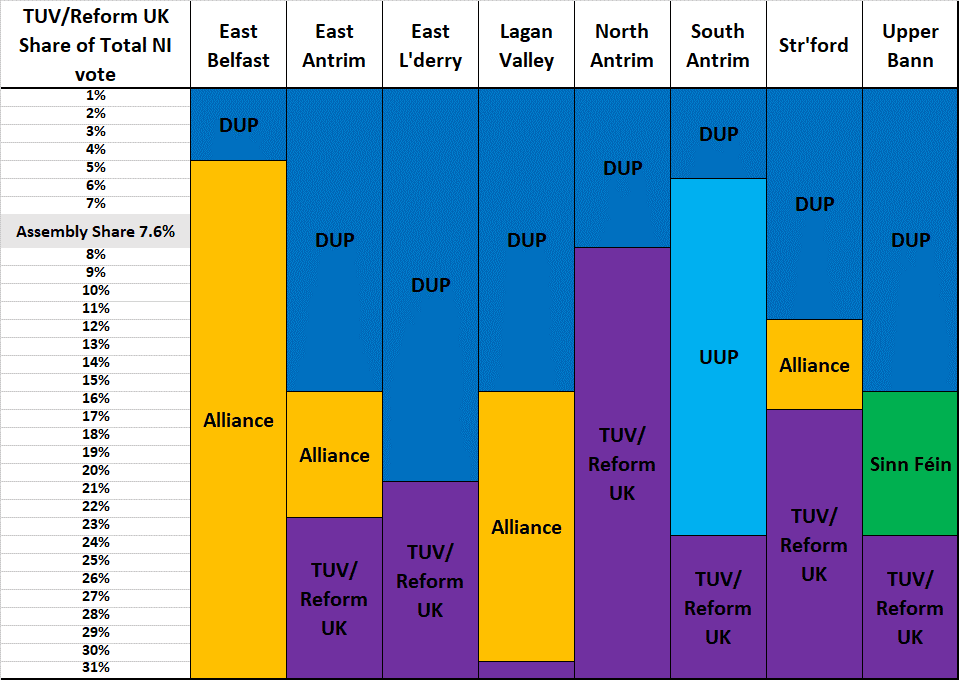

East Belfast would probably fall to Alliance and South Antrim to the UUP even if the DUP retained North Antrim.
In addition to these three DUP seats in obvious danger, there is the special case of Lagan Valley, where voters reaction to the Donaldson charges could be more pronounced and make the outcome less predictable.
UUP: This completes the picture of unionist parties returning to their Assembly level.
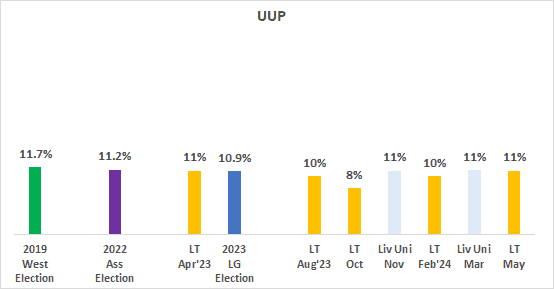

As pointed out above the UUP have a real prospect of taking back South Antrim from the DUP. At an Assembly election they would hold their current seats.
SDLP: Not quite back to Assembly level, but nonetheless some good news for the party at last.
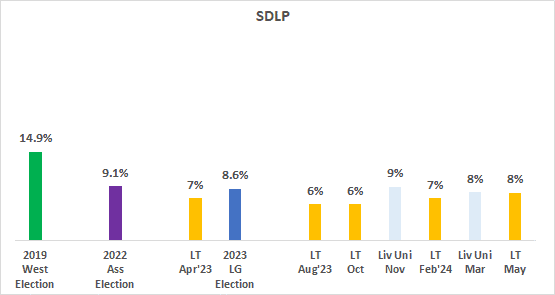

This level of support might just be enough to enable them to hold all their Assembly seats, although they would still be at high risk of losing one. In Westminster terms there is little to read into the results since the party is very highly dependent on tactical voting in both Foyle and South Belfast Mid Down. Nevertheless, it will be particularly welcomed by Colum Eastwood after the recent resignation from the party of two councillors in Derry and Strabane.
Sinn Féin: Yet another party returning to its Assembly level support.
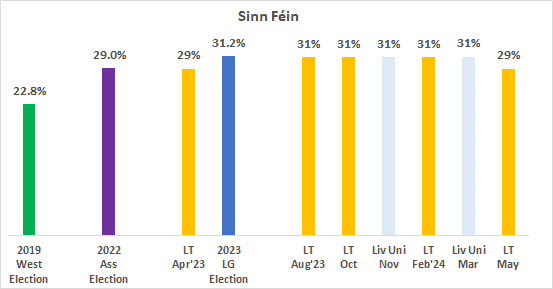

The party will be disappointed by this showing, dropping two points after a consistent run above 30% in all opinion polls and the council elections. There is no obvious reason for this, with Michelle O’Neill’s personal ratings remaining high, one point up at 54%.
Just because there is no obvious reason, it will be important for the party to understand what may be causing them to lose the extra support they had put on since the Assembly election. It will be tempting for SF supporters to dismiss this as margin of error stuff – and it might well be – but if it is not, what is it?
At this level they would not be expected to make gains in an Assembly election, and boundary changes would put one seat in danger in West Belfast. It is for Westminster that this will cause them more concern. Their chances of taking Foyle will have been reduced, and they could be vulnerable in Fermanagh South Tyrone if there were to be a single unionist candidate – although at the moment the position is that the TUV/Reform are committed to running everywhere. The threat to them in North Belfast is a lot less and disappears altogether with a TUV/Reform candidate. However since they cannot be confident that the TUV would not withdraw, SF might be more inclined to seek another non-arrangement with the SDLP resulting in a free run in North Belfast while SF stayed out of South Belfast.
Alliance: Up two points on its Assembly and Council level.
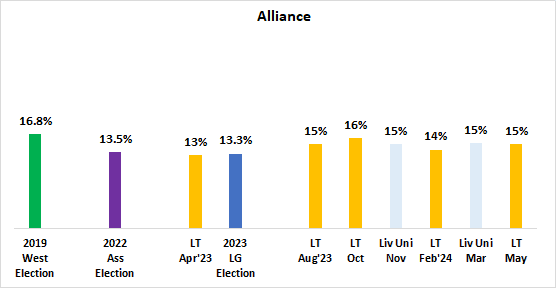

This would almost certainly enable it to hold those of its Assembly seats which are marginal, and give them a good prospect of picking up a further one. It also places it well for Westminster, particularly with the intervention of the TUV/Reform. They must rate their chances high of retaining North Down and gaining East Belfast, with Lagan Valley being possibly in play.
Aontú: Up 1.
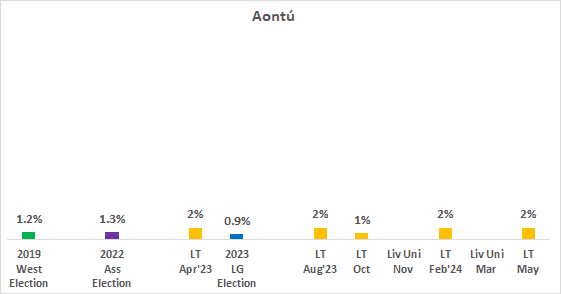

PBPA: No change.
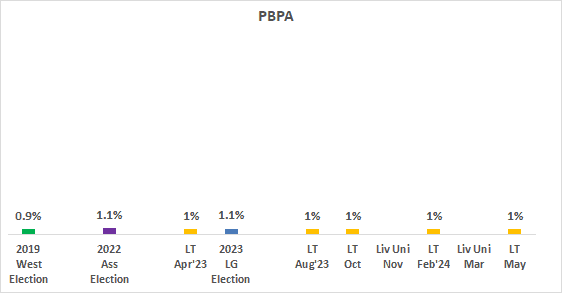

With the decline in the SF showing this should make PBPA’s West Belfast Assembly seat less under threat.
Green: No change. This would almost certainly preclude any prospect of regaining a seat in the Assembly.
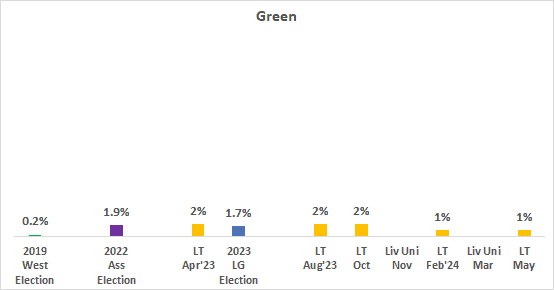

Polling for Westminster
The Belfast Telegraph promise to publish the results of a LucidTalk poll of Westminster voting intentions next week, together with individual constituency predictions. It will be interesting to see how they allow for the different permutations of potential candidates and possible selective withdrawals. Also there will be the issue of small sample sizes leading to larger margins of error in individual constituencies. And if that were not bad enough tactical voting intentions may be highly mobile during the course of the actual campaign. In England the accuracy of individual constituency polling, even with reasonably robust sample sizes, has proved highly variable. I would be inclined to retain a high level of caution at least until the actual slate of candidates is known.
Michael Hehir is a retired sales and marketing manager. He studied in Northern Ireland but now lives between England and Italy.
Discover more from Slugger O’Toole
Subscribe to get the latest posts to your email.
[ad_2]
Source link



